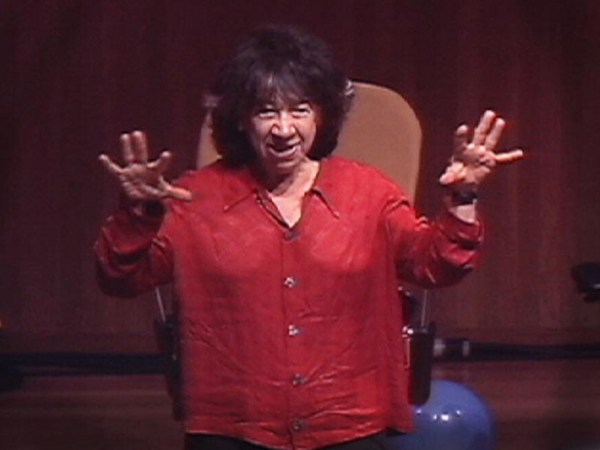I'm going to talk about political protest and papier mache. (Laughter) But for any of this to make sense, I first need to confess something to you, something that might not be obvious just by looking at me. My name's Lucy, and I'm a sensible grown-up. I work hard. I'm a decent mother and a responsible member of my community. But I much prefer dressing up as someone else. You see, I have always loved fancy dress. And since this picture - (Laughter) But since this picture was taken, I've ramped things up a bit. I've commissioned made-to-measure armor from a workshop in the Ukraine, imported professional Hollywood blood. I've nurtured a collection of 36 tiaras. I've had a fake wedding, complete with fake bridesmaids, fake vicar, fake husband. I hospitalized myself once after an incident with a Roman toga and some very hot glue. (Laughter) And I once sent my son to school looking like this. (Laughter) Now, the kind of fancy dress that I love is not the same as cosplay with its discipline and immersiveness and accuracy. They're the real deal. But what I adore is the peculiar eccentricity of cardboard cut-outs, dodgy sewing, stapled seams. It's kitchen-table couture. The for-one-night-only aspect, falling into bed drunk and danced out and still wearing the face paint. And there's nothing disciplined about that. So in order to have more fancy dress in my life - because, honestly, it's awful - you can't do it in supermarkets or on average Wednesdays. So I created a podcast about it. The only podcast about fashion, fantasy, and fancy dress. Or costumes, as they prefer to call it in the US. It's a place to explore the elaborate themes, intricacies, and influence of costume in real life. Because I'm interested in the distinction between the performative and the personal. Ordinary people in extraordinary outfits. And what struck me more than any other subject we've encountered on the show is the way people use costume as a tool for protest. Now, you might be thinking, "What does dressing up have to do with the important business of politics?" (Laughter) And it does seem counterintuitive. Why dress silly in order to be taken seriously? But from caped crusaders to modern suffragettes, people are getting creative with costume to express their outrage and garner global attention. And it's working. It's worth saying here that fashion is often treated as a flimsy, generally female distraction from the real issues of the day, and despite being a three-trillion-dollar industry, it's often marginalized or dismissed in commentary about current affairs. And yet, every day each one of us uses what we wear as a tool for constructing our sense of self, for literally fashioning our identities. If fashion is considered frivolous, then fancy dress is really frivolous. Right? But actually, it allows us to express the most extreme version of ourselves. It allows us to be something other. Something in-between, something in development. And historically, it's always had a relationship with hot topics. Here's a gown by Worth worn by Mrs. Vanderbilt in 1883, representing the spirit of electricity. More recently, there's been a decidedly less beautiful trend for dressing as the Millennial's favorite, the avocado. (Laughter) Sorry. (Laughter) Over the years, fancy dress has playfully depicted controversial moments, from this matchgirl factory-strike dress to Urban Outfitter's Halloween "Influencer" costume. It's satire and disruption and provocation. So I'm going to take us beyond slogan T-shirts to look at the ways bonkers subversive garments are being used to take on the establishment. Here, we can see an anarchic continuity from gunpowder plot through to Occupy Wall Street. These masks taken from the comic book "V for Vandetta," are used as a public face of the anonymous movement. They're a variation on a Guy Folks theme, and they hark back to ancient carnivals and masquerades where the usual societal rules don't apply, and everything is temporarily topsy-turvy. Here, "Handmaid's Tale" costumes are appropriated for demonstrations against the Trump administration, and we saw a lot at the Kavanaugh hearings - taking a moment in fiction from Margaret Atwood's 1985 dystopia, and applying it to a very current conflict, lines of silent, highly visible women outside courtrooms and the Capitol. Hilariously, later, in a complete misjudgment of the cultural mood, the retailer Yandy prompted wide-spread disgust when they launched a sexy version of the Handmaid. (Laughter) I don't think they'd read the novel. (Laughter) Elsewhere, the visual language of the suffragettes is borrowed from new battle, purple for dignity, white for purity, green for hope. Powerful Pantones and a pre-hashtag way of building momentum. Sentiments like "Same shit, different century" are rendered ever so lady-like. (Laughter) The campaign group Fathers for Justice uses a range of costumes in their stunts from Batman to Santa. Clear statements in a contentious debate. By using classic icons of good, by hijacking the visual grammar of superheroism, they're trying to invoke an almost an instinctive, nostalgic, sympathetic response in the viewer. The Pink Pussyhat Project took a traditional domestic skill and rendered it the opposite of calm or comforting. This open-source knitting pattern, this moment of craftivism - originally conceived the people who wanted to march but couldn't - was quickly embraced by women's activists all over the world. Sarah Mower called it a global cheerful symbol of feminist defiance in British Vogue, and it's considered so important a moment in fashion history that the V&A's brilliantly titled Rapid Response Collection have already acquired one. Now, imagine if you took the costumes away in all these examples. If they were just standing there in jeans and anoraks. What does that do the occasion, the atmosphere, the news cycle? Each of these examples uses cultural referencing to make a statement without saying a word. It's free speech without speech, the messages writ large on the body. And how do you express your feelings about issues that are so complex, so shifting, so delicate, so divisive that sometimes language eludes even the very best of us? I just love her face in that picture. (Laughter) At a time when the words of experts are ridiculed and critics are trolled, when fake news rebrands truth as fiction, perhaps we need tools that are beyond language to securely assert our values. I think there's a link between fancy dress and ambition. It's why we love it growing up. You can be a ballet dancer and a firefighter, all in the same afternoon. But for the game to work, you have to do more than just put the clothes on. You need to aspire into those costumes. Fancy dress isn't just a tool to passively join in, but an opportunity to project our future selves, our hopes. And I believe there's a relationship between the way we dress and how brave we feel. I know that because it took me weeks to decide what to wear today. (Laughter) Perhaps, dressing up gives us courage to behave in ways we wouldn't otherwise. Here are some extreme illustrations of that. During the American Civil War, Frances Clayton dressed as a male soldier, becoming Jack Williams. She fought with the Missouri Regiment in 17 battles before her identity was revealed. She used uniform first to disguise her gender, second as armor, a layering of costume that allowed her to elude the male gaze and instead train her eye to fight alongside them. Which, I wonder, was the more dangerous? By wearing her warrior status, Frances was dressing up in order to be allowed in. A whole life born out of those clothes. The women of the 18th century often used the masquerades as an opportunity to elope or escape. Being masked and unchaperoned gave them an unusual freedom, a socially sanctioned moment of disguise to pursue a life beyond the one ascribed to them. The mask made them dangerous and daring. We know how extreme the psychology of this can be because the worst imaginable atrocities have been committed masked and in a kind of costume. A corrupt courage. Cloaked and criminal. A group united as a chilling icon of hatred. Costume isn't intrinsically innocent. And a disguise can free an innermost evil, too. Costume for unity can be seen in a completely different way here: where it says, "She is getting married, so we're having organized compulsory fun." (Laughter) We've all been there. Or here, at the State of the Union, where it says we are part of an empowered tradition honoring the suffragettes' legacy. Simply put, when an activist puts their identity alongside a placard, they show that they, as an individual, express a view. If they want to connect it with a wider movement, they can use a signifier, like the suffragette colors or the "hi-viz" vests of the French "Gilets jaunes." It's tribal. Whereas in fancy dress, the costume subsumes the individual entirely into the view they're expressing. It's as if, bizarrely, when someone is concealed, their true values become completely visible. The arresting protest images I've shown you today, and of course there are many more, all, unequivocally, communicate collective hopes. By protesting in costume, these people are giving voice to their democratic right to imagine a potential future, to identify with each other, and to express their freedom. So costume has real potential to challenge and confront, for disruption and dissent. By dressing outside ourselves, we trick the eye, attract the focus, demand recognition. We creatively tell the people in power that we're not comfortable conforming, that the collective issue is bigger than our personal perspective. Fancy dress is not bound by who you are or how you identify but by the message you want to embody. And those messages aren't constrained by the limits of your experience or your environment. Only by your imagination. And we have to imagine our utopias before we can build them. It is imagination that sells thousands of cheap and cheerful Marilyn Monroe dresses every year. Imagination that sends kids to school clutching Harry Potter wands, and sales figures for grotesque rubber presidential candidate masks have correctly predicted U.S. election outcomes since Nixon. Isn't he handsome there? (Laughter) Unlike any other kind of getting dressed, fancy dress is fundamentally about infinite possibility. That's why we keep it alive, even when technology offers up far more sophisticated vehicles for experimenting or escapism. We still throw another party, hand down our treasured dressing-up boxes, those time capsules of ideas and interpretations. So if dressing together as one brilliant rainbow crew gives you a sense of strength and belonging, a palette just about big enough to celebrate your pride, then use all the colors. Or if you wake up one morning thinking Brexit is a job for Wonderwoman ... (Laughter) you might be right. Or if you're moved to rise up in solidarity in a crowd of pink hats that say in glorious, loving shorthand how your body is equal, how it is not there for grabbing, how it belongs fiercely to yourself, then get knitting. Just as children dressing as astronauts aren't trying out a future career, they're playing with an alternative reality. So we can use the freedom of fancy dress to communicate an imagined, better version of our lives. Because fancy dress says, "This tawdry reality isn't good enough for me." Think of it as dressing up for the job you want, not the job you have. Or for turning one night only into a blueprint for a magical tomorrow, too. Lets remember, fancy dress has a grown-up role to play beyond stag parties and Halloweens. Its principles even have a place at the State Opening of Parliament and the State of the Union. From full get-up to subtle signifiers, this is about being emboldened. Massive movements are born of micro demonstrations. Things that seem trivial or frivolous can be potent symbols of what you stand for, or what you won't stand for. There's real power in putting on those knitted ears, in choosing to wear a cape for good versus evil. Fancy dress has a unifying quality that we can use to fight for change, armed only with glue guns and gumption. And if costume makes up braver, it gives us the courage to explore imaginative alternatives. The courage not just to turn up but to be noticed. So I hope we never grow out of it. Thank you. (Applause) (Cheers) (Whistles)
Related talks
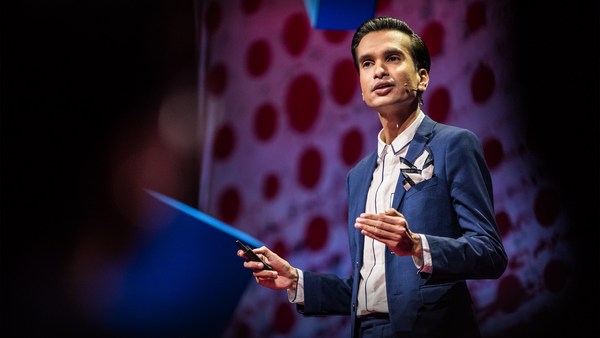
Kaustav Dey: How fashion helps us express who we are -- and what we stand for
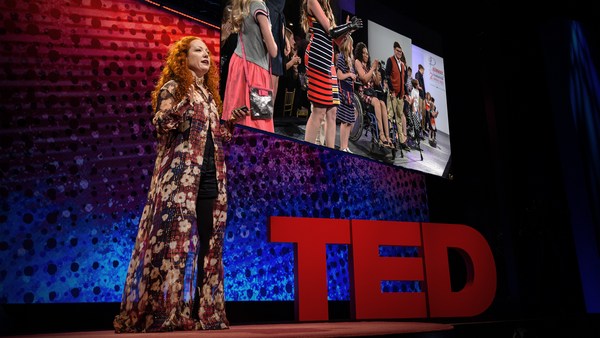
Mindy Scheier: How adaptive clothing empowers people with disabilities
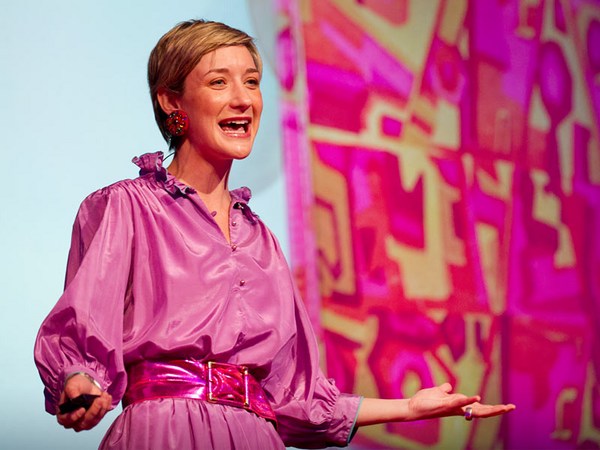
Jessi Arrington: Wearing nothing new
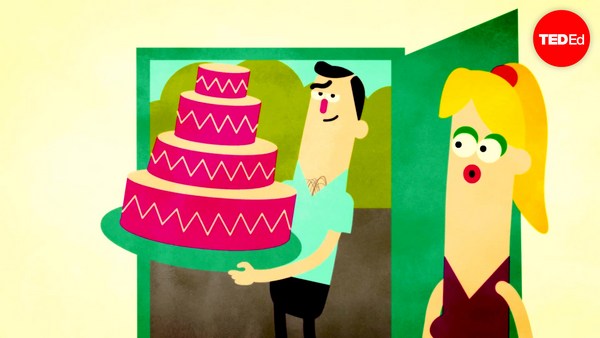
Christopher Warner: Situational irony: The opposite of what you think

Chris Bliss: Comedy is translation
